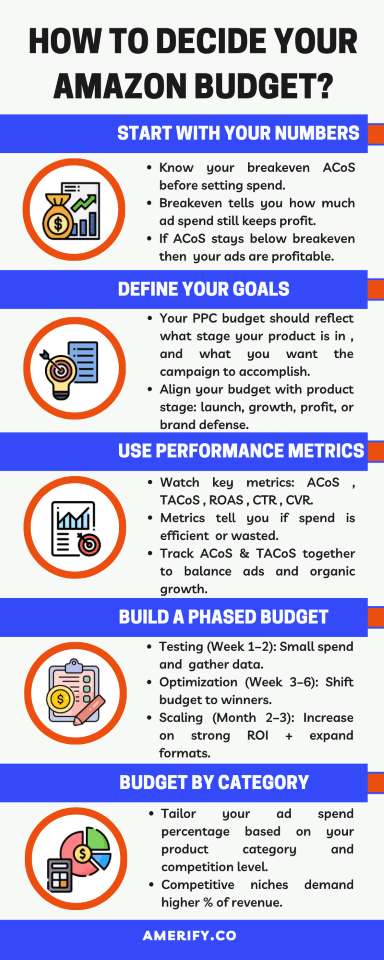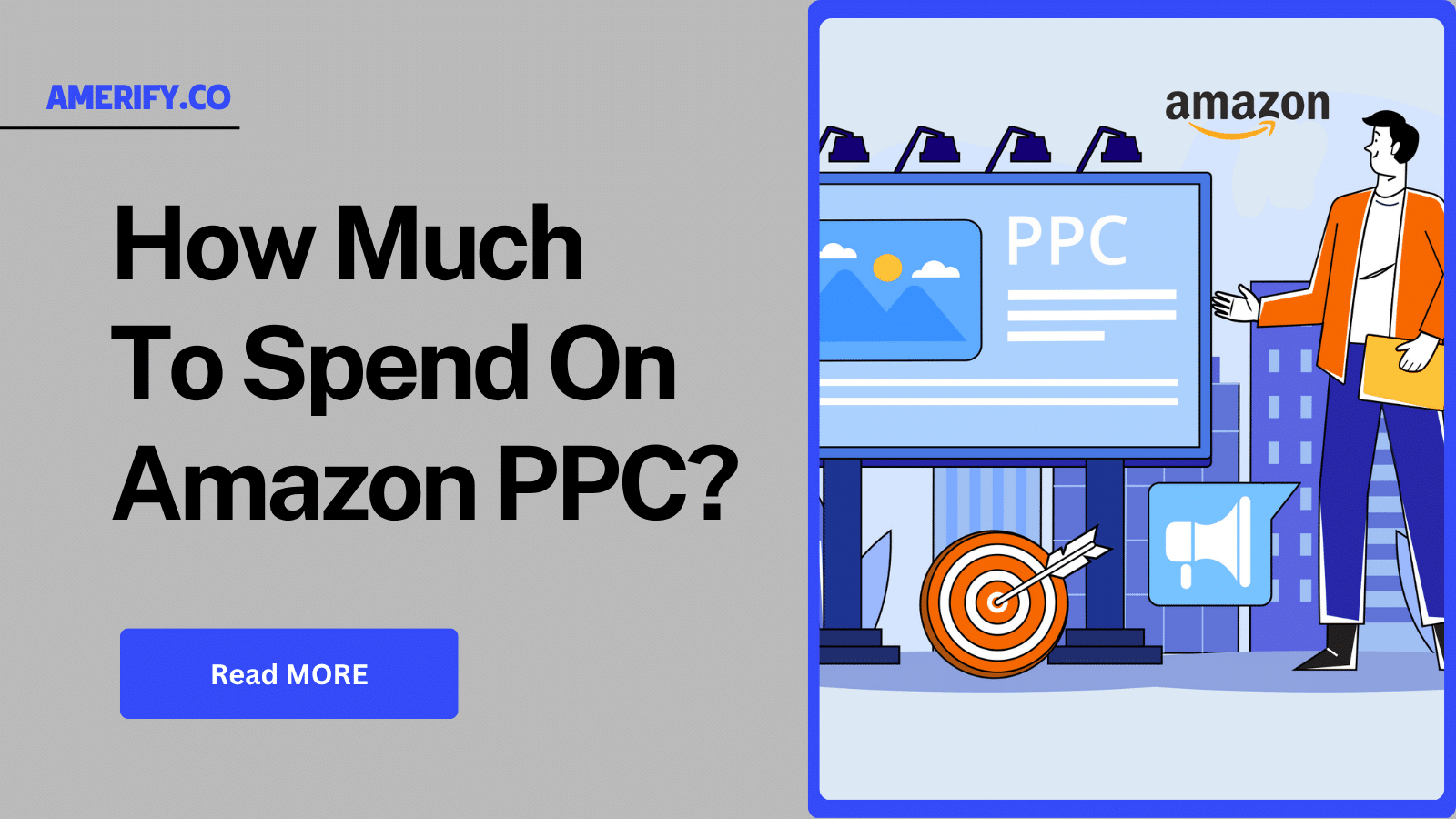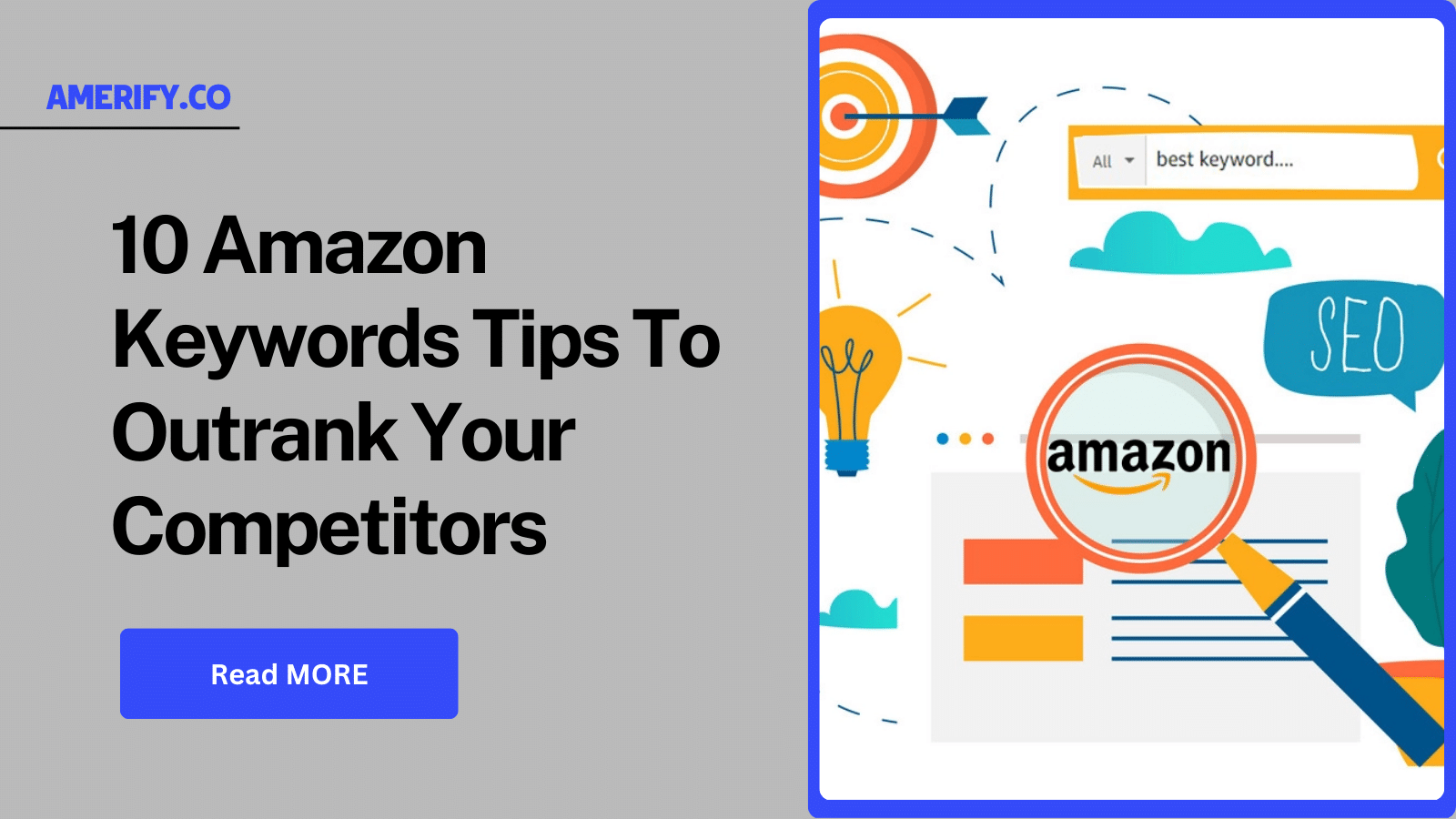Key Takeaways:
- There’s no one-size-fits-all Amazon PPC budget — it depends on your goals, margins, and competition.
- Treat PPC spending as an investment — not a cost. The goal isn’t to spend less, it’s to spend smarter.
- Start with your numbers, test intentionally, and adjust based on performance metrics like ACoS, TACoS, and ROI.
Why Your Amazon PPC Budget Matters?
Amazon PPC (Pay-Per-Click) is one of the most powerful growth levers on the platform — but it’s also one of the easiest to waste money on.
Many sellers make one of two mistakes:
- Spending too little and never gaining visibility.
- Spending too much without understanding profitability.
The truth is, how much you should spend on Amazon PPC depends on what you’re trying to achieve — and how efficiently your campaigns convert that spend into results.
How To Decide Your Amazon Budget?

Step 1: Start With Your Numbers
Before setting a budget, you need to understand your product’s economics.
Calculate Your Breakeven ACoS
Your Advertising Cost of Sale (ACoS) = (Ad Spend ÷ Ad Sales) × 100.
Your breakeven ACoS is the point where your ad costs equal your profits.
If you sell a $40 product with a $20 profit margin (after Amazon fees, shipping, and COGS), your breakeven ACoS is 50%.
That means as long as your ACoS stays below 50%, your ads are still profitable.
Knowing this number gives you clarity on how much you can afford to spend while staying in the green.
Step 2: Define Your Goals
Your PPC budget should reflect what stage your product is in — and what you want the campaign to accomplish.
| Goal | Description | Budget Approach |
| Product Launch | Build visibility and rank for main keywords | Higher spend — up to 25–35% of projected revenue |
| Growth / Scaling | Maintain momentum and push profitable keywords | Moderate spend — 15–25% of revenue |
| Profit Optimization | Focus on efficiency and ROI | Lower spend — 8–15% of revenue |
| Brand Defense | Protect top placements and branded searches | Strategic spend — maintain presence, not aggressive bids |
If you’re launching, your first priority is exposure — not perfect efficiency.
Once the listing gains traction and reviews, your focus can shift to profitability.
Step 3: Estimate Based on Sales Goals
Instead of guessing, reverse-engineer your PPC budget using your sales targets.
Here’s how:
- Decide how many ad-driven sales you want.
Example: You want 100 sales this month from ads. - Estimate your average conversion rate.
Example: 8% conversion rate → You’ll need about 1,250 clicks. - Check your average cost-per-click (CPC).
Example: $0.60 average CPC → 1,250 clicks will cost around $750. - Set that as your monthly PPC test budget.
Now you’re spending based on goals and math — not gut feeling.
Step 4: Use Performance Metrics to Guide Spending
Your budget is only useful if you track how efficiently it performs.
The key metrics to watch:
- ACoS (Advertising Cost of Sale): Shows how much you spend to make a sale.
- TACoS (Total Advertising Cost of Sale): Measures ad spend as a % of total sales (including organic).
- ROAS (Return on Ad Spend): Reveals how much revenue each ad dollar brings.
- CTR (Click-Through Rate): Indicates how appealing your ad is.
- CVR (Conversion Rate): Measures how well your listing turns clicks into purchases.
Amerify Tip:
Track ACoS and TACoS together. If ACoS is stable but TACoS keeps rising, your ads are driving sales — but your organic growth isn’t keeping up.
Step 5: Build a Phased Budget
Don’t commit to one big number right away. Instead, structure your PPC spending in phases:
1. Testing Phase (Weeks 1–2)
- Start small — test broad match and automatic campaigns.
- Gather data on keywords, click cost, and conversion performance.
2. Optimization Phase (Weeks 3–6)
- Shift more budget toward high-performing keywords.
- Lower bids or pause poor performers.
- Start refining match types and adding negative keywords.
3. Scaling Phase (Month 2–3)
- Increase budget where ROI is strong.
- Expand into Sponsored Brands or Display campaigns.
- Layer in remarketing if you’re brand registered.
This phased approach minimizes waste and builds momentum sustainably.
Step 6: Adjust Budget by Category & Competition
Different product categories behave differently.
| Category Type | Suggested Ad Budget % of Revenue |
| Highly Competitive (Electronics, Beauty) | 25–35% |
| Moderate Competition (Home, Kitchen, Sports) | 15–25% |
| Low Competition / Niche Products (Pet Category) | 8–15% |
Step 7: Know When to Increase or Decrease Spend
Your data will tell you when it’s time to make a move.
Increase your budget if:
- You’re hitting daily caps before noon.
- ACoS is stable or dropping.
- Ad-driven sales are rising consistently.
Decrease or reallocate if:
- ACoS or CPCs spike without sales growth.
- Conversion rates fall below category averages.
- You’re overspending on low-converting keywords.
Remember — the best-performing sellers don’t spend more. They spend better, constantly refining where every dollar goes.
Common Budgeting Mistakes to Avoid
- Setting a random monthly cap without data — Always base it on goals and performance.
- Cutting budget too early — Amazon ads need 1–2 weeks to gather meaningful data.
- Ignoring negative keywords — These save budget by filtering irrelevant clicks.
- Running ads on too many products — Focus spend on your best or most strategic listings.
- Not accounting for seasonality — Peak periods (Q4, Prime Day) may need temporary increases.
Example Scenario on How Does Amazon PPC Work?
Let’s say you’re selling a $30 yoga mat with a $10 profit margin.
- Target ACoS: 33% (break-even)
- Average CPC: $0.70
- Conversion Rate: 10%
If you want 150 sales per month:
- You’ll need ~1,500 clicks (150 ÷ 0.10).
- Estimated ad spend = 1,500 × $0.70 = $1,050/month.
- That’s roughly 20–25% of projected revenue — a healthy benchmark for a growing product.
Over time, as your conversion improves, that spend percentage will naturally shrink while sales grow.
Final Thoughts
“How much to spend on Amazon PPC” isn’t a single number — it’s a strategy.
Your ideal budget should:
- Reflect your profit margins
- Match your growth goals
- Adjust dynamically with performance
The smartest sellers treat PPC budgets like living systems — flexible, data-informed, and aligned with profitability.
At Amerify, we recommend starting with clear goals, tracking every key metric, and scaling only what works. Because when your ad spend is intentional, every dollar drives growth, not guesswork.
If you need help with marketing consultation for your Amazon store, our expert team is available to help. Contact us today!



